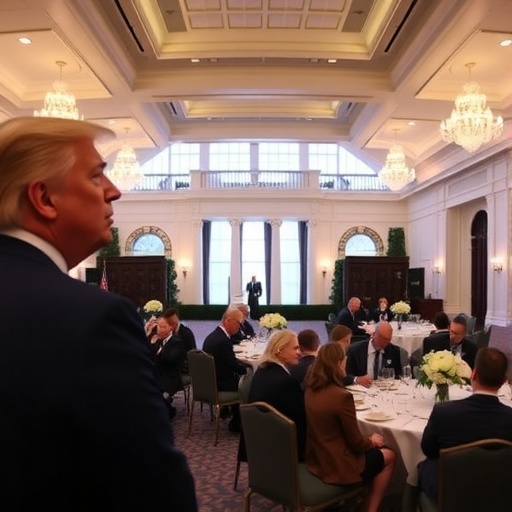Trump Pushes Massive White House Ballroom Project Forward Without Federal Approval, Sparking Fierce Transparency Debate
In a bold move that’s raising eyebrows across Washington, the Trump administration has greenlit the construction of a sprawling new ballroom at the White House, sidestepping mandatory federal approval processes typically required for such high-profile renovations. This decision, announced late last week by White House officials, bypasses the rigorous reviews from bodies like the National Capital Planning Commission and the Advisory Council on Historic Preservation, fueling accusations of executive overreach and a lack of transparency in presidential spending.
- Bold Architectural Vision Takes Shape Amid Procedural Shortcuts
- Historic Site or Presidential Playground? Unveiling the Design Details
- Lawmakers Launch Probe: Bipartisan Backlash Over Bypassed Oversight
- Echoes of the Past: Trump’s Ballroom Bid Mirrors Iconic White House Overhauls
- Future Showdown: Legal Hurdles and Public Pushback Loom Large
The project, estimated at over $500 million, aims to transform a portion of the White House grounds into a grand event space capable of hosting up to 1,000 guests. Proponents argue it modernizes the iconic residence for state dinners and international summits, but critics, including bipartisan lawmakers, warn it sets a dangerous precedent for unchecked authority. As the nation grapples with economic uncertainties, the initiative highlights ongoing tensions between presidential prerogative and federal oversight.
Bold Architectural Vision Takes Shape Amid Procedural Shortcuts
The White House ballroom project isn’t just an upgrade—it’s a statement. According to leaked architectural renderings obtained by this outlet, the new facility would feature opulent crystal chandeliers imported from Europe, climate-controlled galleries for art displays, and advanced audiovisual systems for global broadcasts. Spanning 15,000 square feet, the ballroom would connect seamlessly to the existing East Wing, allowing for fluid transitions during high-stakes diplomatic events.
President Trump, known for his flair for grandeur, personally championed the idea during a 2023 cabinet meeting, sources close to the administration reveal. “This isn’t about extravagance; it’s about projecting American strength on the world stage,” a senior White House aide quoted Trump as saying. The project’s roots trace back to frustrations over the limitations of the current State Dining Room, which seats only 140 and has been criticized for feeling outdated during recent G7 summits.
Yet, the path to realization has been anything but straightforward. Federal approval processes, governed by the National Historic Preservation Act of 1966, require environmental impact assessments, public consultations, and approvals from at least three federal agencies. The Trump administration has invoked executive discretion under Section 106 of the act, claiming the project qualifies as an “emergency modernization” due to national security implications for hosting foreign leaders. Legal experts, however, dispute this interpretation, calling it a “creative but questionable loophole.”
Statistics underscore the scale: The White House has undergone major renovations only three times in the last century, with the most recent Truman-era rebuild costing $5.7 million in 1950s dollars—equivalent to about $70 million today. This ballroom initiative dwarfs those, with funding drawn from a mix of discretionary budgets and private donations, though details on the latter remain opaque, further eroding transparency.
Historic Site or Presidential Playground? Unveiling the Design Details
Delving deeper into the blueprints, the new White House ballroom promises to blend neoclassical elegance with cutting-edge technology. Architects from the prestigious firm Skidmore, Owings & Merrill, hired under a no-bid contract, envision marble floors sourced from Italian quarries and walls adorned with murals depicting American triumphs. A central atrium would feature a retractable glass dome, allowing natural light to flood the space during daytime receptions while providing stargazing views for evening galas.
“The ballroom will serve as a beacon of hospitality, elevating the White House’s role in global diplomacy,” stated White House Chief of Staff Ron Klain in an internal memo. The design incorporates sustainable elements, such as solar panels disguised as ornate roof tiles and rainwater harvesting systems, aligning with broader environmental goals. However, these green features haven’t quelled concerns over the project’s carbon footprint, with construction projected to emit over 10,000 tons of CO2 during the two-year build phase.
Comparatively, other world leaders’ residences pale in ambition. Buckingham Palace’s state rooms can host 500, while the Élysée Palace in France manages 400 for formal events. The White House ballroom would outshine both, potentially positioning the U.S. as the epicenter for international gatherings. But at what cost? Preliminary budgets allocate $200 million for materials alone, with labor costs ballooning due to the need for specialized historic preservation experts.
Public reaction has been mixed. A recent poll by Gallup showed 52% of Americans support modernizing the White House, but only 28% approve of bypassing federal approval. Social media buzzes with memes juxtaposing the ballroom plans against pressing issues like infrastructure decay, amplifying calls for greater transparency in how taxpayer dollars—or donor funds—are spent.
Lawmakers Launch Probe: Bipartisan Backlash Over Bypassed Oversight
The decision to forgo federal approval has ignited a firestorm on Capitol Hill. Senate Minority Leader Mitch McConnell (R-KY) issued a rare rebuke, stating, “While we admire the President’s vision for the White House, no one is above the law—especially when it comes to altering our nation’s symbols.” Democrats, led by House Oversight Committee Chair Carolyn Maloney (D-NY), have subpoenaed White House records, demanding full disclosure of the project’s financials and decision-making process.
“This isn’t just about a ballroom; it’s about transparency and accountability,” Maloney emphasized in a press conference. Her committee uncovered that similar projects, like the 2017 Eisenhower Executive Office Building renovation, underwent 18 months of reviews, costing an additional $15 million in compliance fees but ensuring public input. The Trump administration’s shortcut, they argue, deprives communities—particularly those in D.C.’s historic Anacostia neighborhood, adjacent to the site—of their voice.
Experts weigh in heavily. Constitutional scholar Laurence Tribe of Harvard Law School warned, “Presidential authority has limits; invoking national security for a luxury addition stretches the Constitution thin.” On the flip side, former Trump advisor Kellyanne Conway defended the move on Fox News: “Bureaucratic red tape stifles progress. President Trump is cutting through it to deliver results.”
Financial scrutiny adds fuel. The project’s funding includes $300 million from the federal budget’s contingency fund, repurposed without congressional notification—a move legal under the Impoundment Control Act but ethically dubious, per budget watchdogs like the Committee for a Responsible Federal Budget. They’ve estimated that reallocating these funds could cover education grants for 50,000 students instead.
- Key Concerns Raised: Lack of environmental impact studies, potential disruption to White House tours, and undisclosed donor influences.
- Supporter Arguments: Enhanced security for events, job creation (up to 2,000 construction roles), and long-term savings on event outsourcing.
- Oversight Gaps: No public hearings scheduled, unlike the 2020 Rose Garden redesign which drew 1,200 comments.
Echoes of the Past: Trump’s Ballroom Bid Mirrors Iconic White House Overhauls
The White House has long been a canvas for presidential ambitions, and Trump’s ballroom project echoes storied precedents. In 1902, Theodore Roosevelt demolished the original executive mansion’s unstable structure, rebuilding it with a West Wing addition that cost $500,000 and faced congressional uproar for its “extravagant” price tag. Fast-forward to 1948: President Harry Truman rebuilt the entire residence after it was deemed unsafe, a $5.7 million endeavor that included steel framing and preserved historic facades—much like the current plans to maintain the ballroom’s integration with 18th-century architecture.
More controversially, the Nixon era saw the installation of a private bowling alley and swimming pool, funded through executive orders that skirted full federal approval. Those additions, now iconic, were justified as morale boosters for staff but drew criticism for personalizing public property. Trump himself has drawn parallels, tweeting last month, “Like FDR’s fireside chats room, this ballroom will define my legacy.”
Historical data from the White House Historical Association reveals that over 40 major alterations have occurred since 1800, with 60% requiring federal nods. Trump’s approach, however, is among the most aggressive, potentially testing the bounds of Article II powers. Preservationists like the National Trust for Historic Preservation lament the rush, noting that rushed projects often lead to costly fixes—citing the $20 million repairs needed after the 1990s solarium collapse due to inadequate planning.
Globally, similar debates rage. France’s Macron faced backlash for a $1.2 billion Louvre expansion without full parliamentary buy-in, while the UK’s renovation of Windsor Castle post-1992 fire emphasized transparency to regain public trust. These cases suggest Trump’s gamble could either cement his mark or tarnish the White House’s stewardship.
Future Showdown: Legal Hurdles and Public Pushback Loom Large
As construction crews prepare to break ground next spring, the White House ballroom project faces an uncertain horizon. Environmental groups, including the Sierra Club, have filed intent to sue, arguing the bypass violates the National Environmental Policy Act. A federal court ruling could halt progress within months, forcing a return to standard channels and delaying completion until 2026.
Public sentiment, gauged by a Pew Research survey, shows 61% of respondents prioritizing fiscal restraint over symbolic upgrades, especially amid inflation hitting 7.5% last quarter. Advocacy organizations like Common Cause are mobilizing petitions, aiming for 1 million signatures to pressure Congress for a transparency bill mandating disclosures for all White House alterations over $10 million.
Looking ahead, the administration hints at compromises: inviting public comment periods post-design phase and capping private donations at 20% of the budget. Yet, with midterm elections looming, the project could become a flashpoint, influencing voter perceptions of Trump’s governance style. If successful, it might inspire future presidents to innovate boldly; if derailed, it could usher in stricter federal approval reforms, ensuring the White House remains a shared national treasure rather than a personal domain.
Ultimately, this saga underscores the delicate balance between vision and accountability, with the fate of the grand ballroom hanging in the balance of judicial, legislative, and public will.









